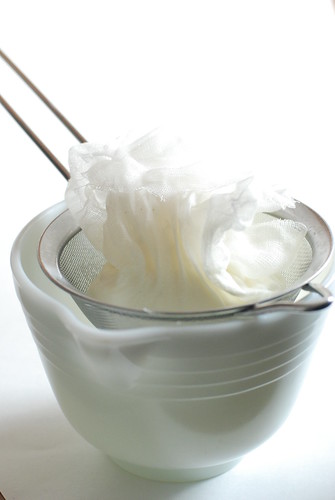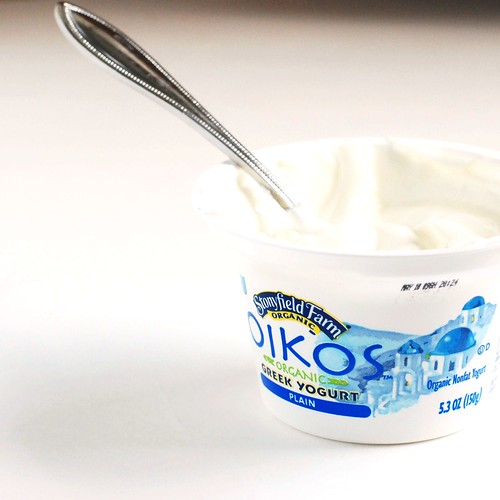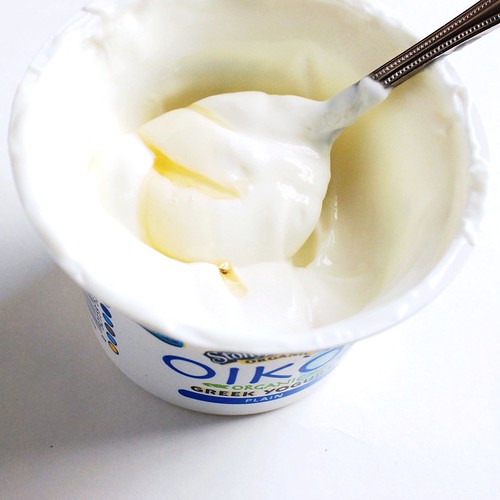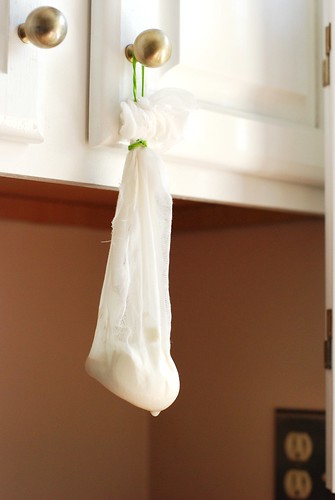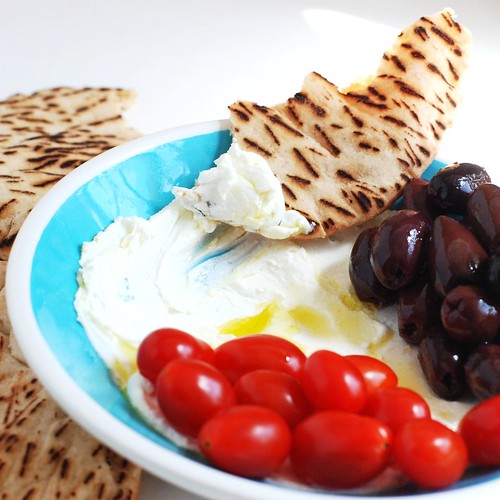how to make labneh (yogurt cheese)
So by now we all know that milk (after a little cooking and straining) becomes yogurt, and strained yogurt becomes Greek yogurt, but if you keep straining for a little longer, you get yogurt cheese. Think fat-free cream cheese, except without weird ingredients like structuring proteins, and you can make it at home. I have no problem with chemicals, but I am a fan of simplicity, and if I can eat the same thing with less stuff in it, I’d rather.
So as it turns out yogurt cheese is called different things in different places. This foodstuff came to my attention at a Middle-Eastern restaurant where it was called “labneh,” alternately spelled “labaneh,” its Lebanese name. Indians call it “dahi,” and for some reason Wikipedia seems to think it’s the same thing as Greek yogurt. Since I do operate under the assumption that Wikipedia knows better than I, so I’m guessing that Greek yogurt is technically a particularly loosely-textured yogurt cheese. Given its recent commercialization, I will refer to Greek yogurt as the stuff you get in the store and yogurt cheese as the stuff with a texture like cream cheese.
At this point, I can’t imagine I’m spoiling anything by pointing out that this post could be alternately titled “how to make labaneh,” “how to make labneh,” “how to make dahi,” or “how to make yoghurt cheese.”
For the last few weeks I’ve been experimenting on how to get this right. Since yogurt is cheaper to get in large quantities, I’d been straining it extensively, if effort put into leaving something there for awhile can accurately be described as “extensive.” Seemed easiest to do it with a strainer.
And uh, I ended up with Greek yogurt. With a strange sort of texture.
I tried a few variations on this: in the fridge and on the counter, each checked every 12 hours or so and I never really got any further than Greek yogurt (for the record, on the counter is quicker). Which is all well and good, except that I can buy Greek yogurt at the store, and the quality is better, and given the yield per cup of yogurt, it costs about the same too, so as far as I’m concerned there’s no convincing argument to make Greek yogurt at home, other than maybe to try it out and get some indie cred from your more-tattooed friends.
And besides, I wanted labneh, which I can’t buy at the store, and wtf is up with the yogurt that refuses to cooperate? The entire internet agreed it only takes 24 hours to make this shit!
Just then, a little piece of my childhood reached out with a warm, knowing smile.
Alright, I lied, it was an email from someone I’ve never met who may have been smiling, but I wouldn’t know. What I do know, however, is that she works for Stonyfield Farm. I grew up going on field trips to Stonyfield Farm, as their headquarters are situated a few towns over from my hometown. I’m pretty sure that their organic yogurt was the first time I’d ever even seen the word “organic” on a foodstuff, because that trend took a little while to make it to New Hampshire. These people are trendsetters.
So Stonyfield wants to create some food blog buzz about their new organic, fat free, low cal, totally delicious Greek yogurt, affectionately called “Oikos” by sending along some “get it free” coupons. I was happy to accommodate for a few reasons. Excellent opportunity for a list.
- Food blog perks. Yay!
- What a convenient coincidence, I have been buying lots of yogurt lately for this labneh thing and could use the discount.
- I’m definitely not an organic foodie, but I am a HUGE proponent of buying local. Stonyfield Farm is a scant 50 miles from my home, which in food-source terms is my backyard.
- I figured out some food science.
So what do you do with Greek yogurt, other than just substitute it for regular yogurt in stuff? Well, there’s the boring but tasty “stir in some vanilla and honey” thing.
But I wouldn’t really call that a recipe. So I strained it, figuring that starting out at the Greek yogurt stage would cut my work in half and I could do a little product placement and maybe it would even work this time.
This reminds me of the stork’s creepy baby-in-a-bag thing! I do this at room temperature because it seems to work more quickly and because it’s kind of a pain in the ass to work around a big bowl in my fridge. And I mean, we’re effectively just breeding bacteria here anyway, so this method doesn’t make me all that squeamish.
After just an overnight stint in the suggestive sling *ahem* I awoke to sheer delight. LABNEH! My quest, it was ended.
A perfect cream cheese texture . . . smooth, none of the weird pebbliness of previous attempts. I refused to believe this was just because organic is better, and compared Stonyfield’s ingredient list to that of other fat free yogurts. Turns out that Stonyfield has only milk + bacteria, whereas the other three cartons I examined included pectin or milk solids as thickeners. Now in terms of eating yogurt straight up, I don’t care if it’s thick because of milk solids or gelatin or inferior bacteria, but for my purposes here, Stonyfield worked out pretty well.
So here’s what you came for:
How to Make Yogurt Cheese
1 5.3 oz cup Greek yogurt (ingredients should be just milk + bacteria—no milk solids, pectin nor gelatin allowed!)
1 pinch salt
a piece of cheesecloth or muslin or even a very strong paper towel if you are daring
some place to suspend a leaky bag of yogurt overnight
Mix the yogurt & salt, make a bag out of the cheesecloth, then suspend it at room temperature for 8-12 hours with a bowl underneath to collect the whey as it drains off.
That’s pretty much it. Notes:
- I use a rubber band to hang the parcel from a cabinet knob.
- You can try this in the fridge, it will take a little bit longer.
- And you can use regular yogurt too, but it too will take longer. Regular, non-Greek yogurt will yield about 1/3 c for every cup you use.
- 3.5 oz of Stonyfield Farm Oikos yielded about 1/3 c yogurt cheese as well. Amount will vary depending on how long you strain and what brand of Greek yogurt you use.
Serve in one of the manners below.
Traditional Labneh
like how I had it at that restaurant that time
Spread some of the yogurt cheese on a plate, drizzle some olive oil atop, serve with any combination of the following: pita, olives, tomatoes, chickpeas, cucumbers, hummus, bruised mint, sprinkles of other herbs or spices. Simple but the best application I’ve found to date.
Jalapeno Yogurt Cream Cheese
1/3 c yogurt cheese (this recipe also works just fine for cream cheese if you omit the olive oil)
a drop or two of olive oil (brings out flavour)
pinch garlic powder
1/4 jalapeno, seeded and finely diced
Mix. Let mingle in fridge for a good while. Overnight would be ideal. Serve. Let me know if you try this one, I think it could use some work, but the idea is solid.

Cheaty-Pants Light Cherry Cheesecake Bites
makes just a few—eat alone or share with 1 other friend
1/3 c yogurt cheese
2-3 graham crackers (before you snap at perforation)
2 tsp sugar
2 drops vanilla extract
frozen cherries, thawed
Mix the yogurt cheese with the sugar and vanilla. Okay, NOW snap the graham crackers at the perforation, then slice each baby rectangle in half to make little squares. Spread a little cheesecake mixture onto each square, then top with a cherry and a little extra sprinkle of sugar. The graham crackers will get soggy very quickly, so these are not make-ahead nor party friendly. Think of it as a special private little treat to enjoy as you make them.



